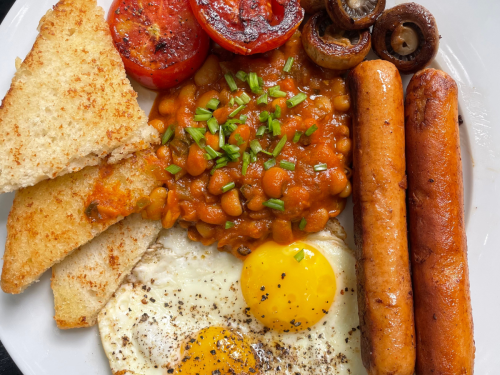
Introduction
When it comes to iconic breakfasts, the Traditional Full English Breakfast is a true heavyweight champion. Picture a plate piled high with sizzling bacon, perfectly fried eggs, plump sausages, and all the trimmings. It’s a heartwarming and hearty meal that has been a beloved staple of British cuisine for generations. In this comprehensive guide, we’ll explore the origins, ingredients, cooking techniques, and regional variations of this classic morning feast.
The Origins of the Full English Breakfast
A Glimpse into History (H1)
The Full English Breakfast, often simply referred to as a “Full English,” has a history as rich and diverse as its flavors. It emerged in the late 19th century as a response to the Industrial Revolution’s demands for a substantial and energy-packed morning meal. Workers needed fuel to power through long and grueling days in factories and coal mines.
An Ever-Evolving Dish (H2)
Over time, the components of the Full English Breakfast have evolved. The breakfast was initially a meal for the wealthy, featuring game meats, kidneys, and other luxury ingredients. As it gained popularity, it became more accessible to the general population, incorporating ingredients like bacon, eggs, and sausages.
Key Ingredients (H1)
Bacon: The Crown Jewel (H2)
Bacon is undoubtedly the star of the Full English Breakfast. Crispy, smoky, and savory, it’s the perfect accompaniment to eggs and beans. Back bacon and streaky bacon are the two most common types used in this dish.
Eggs: Sunny Side Up (H2)
Fried eggs, usually served sunny-side-up, add a delightful creaminess to the plate. They’re often cooked in the same pan as the bacon, soaking up its flavors.
Sausages: Bangers Galore (H2)
Sausages, known as “bangers,” come in various types and flavors. From Cumberland to Lincolnshire, each region has its own signature banger, contributing to the diverse range of Full English Breakfasts.
Black Pudding: A Controversial Delicacy (H2)
Black pudding is a divisive ingredient made from pig’s blood, suet, and oats. It adds a unique texture and flavor to the meal, and many consider it an essential part of the Full English Breakfast.
Tomatoes and Mushrooms: A Touch of Freshness (H2)
To balance the richness of the other ingredients, grilled tomatoes and sautéed mushrooms provide a refreshing contrast.
Baked Beans: A Surprising Addition (H2)
A tin of baked beans might seem out of place, but it’s a beloved component of the Full English Breakfast, adding a touch of sweetness and sauce to the plate.
Cooking the Perfect Full English Breakfast (H1)
Pan and Heat (H2)
Start by heating a large frying pan over medium heat. This is where most of the magic happens.
Bacon and Sausages (H2)
Fry the bacon until it’s crispy, then set it aside. In the same pan, cook the sausages until they’re browned and cooked through.
Eggs and Black Pudding (H2)
Using the same pan to infuse the eggs with bacon flavors, fry the eggs until the yolks are still runny. In a separate pan, cook the black pudding until it’s heated through.
Tomatoes, Mushrooms, and Beans (H2)
Grill the tomatoes and sauté the mushrooms until they’re tender. Heat the baked beans in a saucepan.
Plating (H2)
Arrange all the cooked ingredients on a plate, and your Full English Breakfast is ready to be devoured.
Regional Variations (H1)
The London Fry-Up (H2)
In the capital city, you’ll often find the inclusion of fried bread, bubble and squeak (a potato and cabbage dish), and sometimes even a slice of grilled steak.
The Scottish Breakfast (H2)
Scotland puts its own twist on the Full English by adding haggis and tattie scones to the mix.
Conclusion
The Traditional Full English Breakfast is a culinary masterpiece that has stood the test of time. Whether you prefer it simple or with regional variations, this iconic morning meal never fails to satisfy. So, next time you’re looking for a hearty breakfast to kick-start your day, consider indulging in the comforting embrace of a Full English Breakfast.

